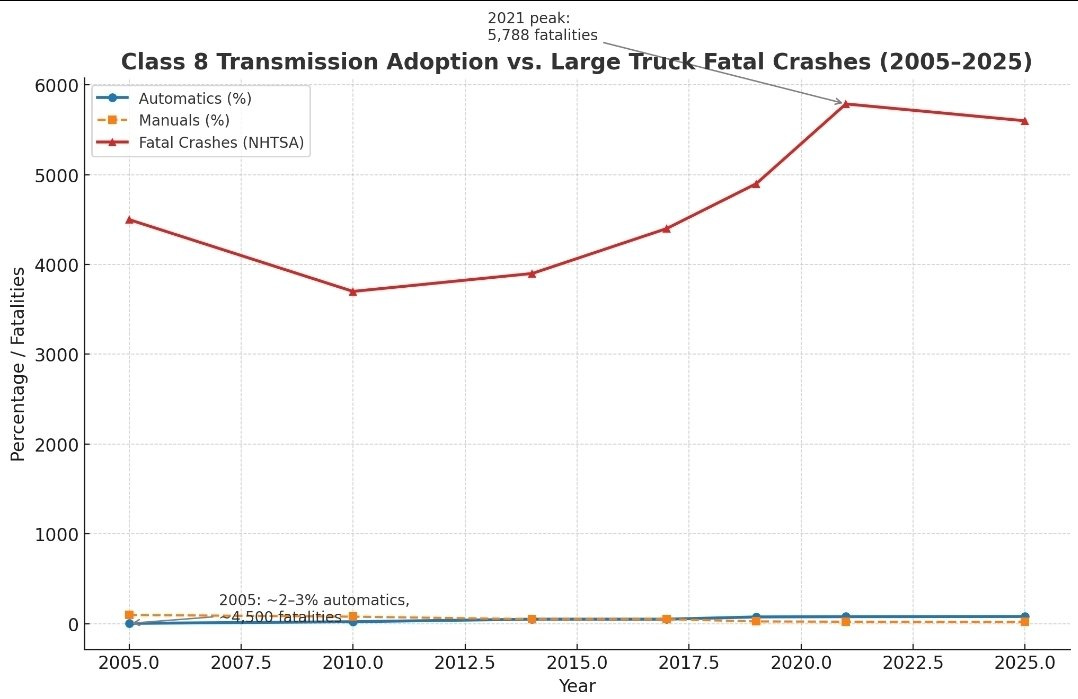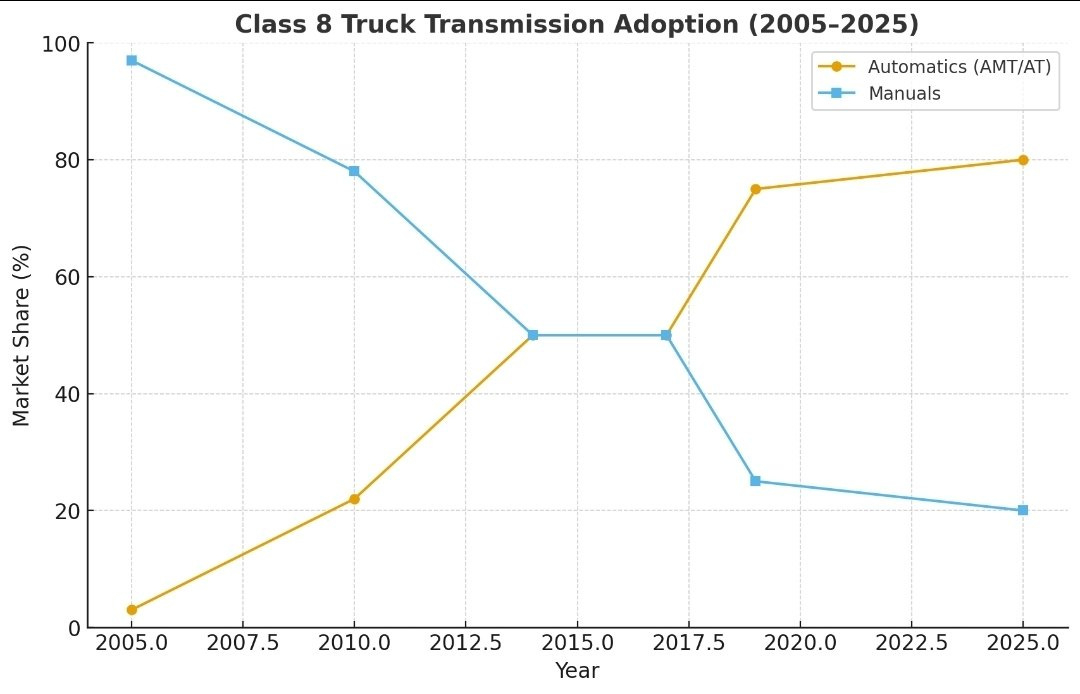Trucking’s Race to the Bottom and Driver Non-Appreciation Week
How the trucking industry, in two short decades, systematically lowered barriers to entry, abandoned professional standards, and drivers resulting in devastating consequences for highway safety
In 2005, when 95% of Class 8 trucks rolled with manual transmissions, America recorded approximately 4,500 fatal crashes involving large trucks. Fast-forward to 2021's peak of 5,788 fatalities, a 29% increase, and you'll find that manual transmissions had all but disappeared from new truck sales, replaced by automatics in 75-80% of the fleet.
This is the inevitable result of a two-decade assault on professional trucking standards, dressed up as "solving the driver shortage" but really about cramming unqualified bodies into seats at rock-bottom wages.
I've spent 30 years watching this industry, and what we're witnessing is a systematic dismantling of everything that once made truck driving a skilled profession. The automatic transmission revolution was just the beginning.
Why The Manual Transmission Mattered
Let me tell you something the industry apologists won't…the manual transmission was a filter.
To master a 13-speed or 18-speed manual in a loaded 80,000-pound machine required timing, coordination, and mechanical understanding that separated the wheat from the chaff. You couldn't fake it. You either had the skills and dedication to learn proper shifting technique, or you washed out.
Today's automatic transmissions? Any chucklehead with a pulse can operate one, and that's precisely the point. Several weeks ago, we had a tanker hijacking in Los Angeles. Only possible because the truck had an automatic transmission. Anybody can drive one.
The transformation happened at breakneck speed. In 2005, automatic transmissions represented a mere 2-5% of Class 8 truck sales. By 2017, the split was 50-50. Today, you'd be hard-pressed to find a manual transmission in a new long-haul tractor. Almost every file we review has a manual restriction.
OEMs sold this change as "driver retention" and "efficiency." What they really delivered was the ability to hire anyone who could fog a mirror. As someone who owned fl
eets and trains drivers and drives trucks, newer drivers were destroying equipment because they simply could not shift gears. Some of this change was to ensure equipment lifecycles were maintained, but that's the point: if you can't shift, you shouldn't drive.
The "driver shortage" that supposedly justified this race to the bottom? It's largely fiction.
Research shows the shortage isn't about bodies, it's about qualified, professional drivers willing to work for substandard wages and conditions. The widely perceived truck driver shortage is a myth, primarily affecting large fleets, while the market quickly adjusts to capacity needs.
The proof is in the turnover rates. Today's long-haul carriers report turnover rates approaching 95%. That's not a shortage, that's a retention crisis caused by treating professional drivers like interchangeable parts. Mainly because we just need to buy time until AVs can replace the dock bumper roles. The automatic transmission lobby, backed by the ATA, and carriers desperate for workers, needed a crisis to justify their erosion of standards. So they manufactured one.
Death by a Thousand Cuts
The assault on manual transmissions was just the opening salvo. Here's what else got gutted:
Training Requirements. The 2022 Entry-Level Driver Training (ELDT) rule was supposed to raise standards. Instead, it codified mediocrity. With no required minimum instruction hours for training, and company-sponsored mills proliferated with 100% company sponsorship, and no out-of-pocket costs. Get your CDL in maybe a day or maybe three weeks, start earning immediately, and don't worry about actually understanding how to operate a machine safely.
Experience Requirements. The push to lower the interstate driving age from 21 to 18 continues gaining steam. Federal exemptions now allow some to skip the traditional one-year training requirement. Fast-track programs replace traditional apprenticeships, where veteran drivers mentored newcomers.
Financial Barriers. States throw millions at CDL training programs. Iowa alone allocated $6 million to "reduce barriers" for CDL training. Colorado pays employees to obtain their CDL to "attract skilled employees looking for meaningful careers," except that the careers themselves are no longer considered skilled.
Language Standards. Despite recent enforcement pushes, English proficiency requirements remain inconsistently applied. The ability to communicate clearly with dispatchers, law enforcement, and customers, once considered essential, is now treated as optional.
The Body Count
The consequences aren't just academic. They're written in blood on America's highways.
Fatal crashes involving large trucks increased 52% from 2010 to 2021. Truck occupant deaths rose 83% over the same period. The involvement rate per 100 million large-truck miles traveled is up 22% in the last decade alone.
This isn't happening in a vacuum. Federal studies show drivers with less than three years of experience are 47% more likely to cause a serious accident than veterans. When you systematically lower barriers to entry, you flood the roads with inexperienced operators in 80,000-pound missiles.
Despite massive investments in safety technology, collision avoidance systems, lane departure warnings, and electronic logging devices, the carnage keeps climbing. Technology can't fix stupid, and it can't replace the situational awareness that comes from proper training and experience.
The Insurance Apocalypse
While bodies pile up on highways, the industry faces an insurance crisis that threatens its financial viability. Trucking insurance premiums have exploded 47% over the last decade, rising from 5.9 cents per mile to 8.7 cents. Some carriers report premium increases of 20-30% annually. The average fleet now pays $12,000 to $17,000 per truck for basic coverage.
"Nuclear verdicts," lawsuit awards exceeding $10 million, set new records annually. So-called "thermonuclear" verdicts above $100 million are becoming routine. Even smaller settlements that once averaged $80,000-$100,000 now commonly exceed $400,000.
Insurance companies are fleeing the market entirely or imposing coverage limits that leave carriers exposed. The few insurers remaining jack up rates to compensate for massive claim payouts. This isn't sustainable. Small carriers, the backbone of American trucking, making up roughly 93% of the trucking industry, are being priced out of existence. The survivors pass these costs on to shippers, who then pass them on to consumers.
The Professional Death Spiral
We've lost the culture that once made trucking a respected profession. The old-timers who took pride in their three-million-mile safety records, who mentored rookies, who viewed driving as a craft to be mastered, they're retiring or being driven out by an industry that values quantity over quality.
What's replacing them? A revolving door of minimally trained operators who view trucking as a temporary gig between "real" jobs. Turnover rates near 95% mean there's no institutional knowledge, no mentorship, no professional development. Companies find it cheaper to accept high turnover than invest in driver retention. As one researcher noted, "High turnover is structurally ingrained in the trucking industry due to 'destructive competition,' making it more profitable for companies to accept high turnover than to invest in higher wages and improved driver retention."
The result is an industry of permanent beginners operating increasingly complex equipment on increasingly congested roads.
The Real Shortage
There is a shortage in trucking. It's not dock bumpers, it's qualified, professional drivers willing to work in an industry that's abandoned its standards. There's a shortage of drivers who can handle a manual transmission, read a map without GPS, secure a load properly, and conduct a real pre-trip inspection. There's a shortage of drivers who understand that they're operating a potential weapon and take that responsibility seriously.
There's a shortage of drivers who view trucking as a career worthy of professional pride rather than a stepping stone to something better. There's a shortage of drivers who understand their moral and ethical role in sharing the highways with our mothers, sisters, daughters, and everyone in between. There's a shortage of companies willing to invest in developing such drivers instead of churning through whoever's desperate enough to take their insulting wages and working conditions.
Fixing this mess requires admitting it exists, something the industry has been reluctant to do. The ATA is still looking for the imaginary group that started this whole mess, and more drivers were apparently still believing there was a shortage of.
We need to restore manual transmissions as a licensing requirement, not an option. If you can't operate the most basic truck transmission, you have no business behind the wheel of an 18-wheeler.
We need meaningful training standards with mandatory minimum hours, hands-on instruction, and competency testing that actually tests competency. Three-week CDL mills should be illegal.
We need to eliminate company-sponsored training programs that create indentured servants instead of professional drivers. If companies want qualified drivers, they should pay market wages to attract people who've invested in proper training.
We need to stop lowering age requirements and start raising experience requirements. Some jobs require maturity and judgment that come with age. Operating an 80,000-pound truck is one of them.
Most importantly, we need to treat trucking like the skilled profession it should be, not the unskilled labor it's become.
The trucking industry can continue down the current path, chasing the bottom with ever-lower standards, ever-cheaper labor, and ever-more-dangerous roads. The insurance crisis will worsen, the lawsuits will multiply, and public confidence in trucking will collapse entirely.
Or it can choose to rebuild professional standards, demand real qualifications, and treat driving as the skilled profession it once was. The automatic transmission revolution opened the floodgates to mediocrity. It's time to close them before the entire industry drowns in the consequences of its own race to the bottom.
The highways are littered with the evidence of what happens when we prioritize filling seats over safety. How many more people have to die before we admit that lowering barriers to entry was a catastrophic mistake?
The Irony of Driver Appreciation Week in 2025
As the trucking industry celebrates Driver Appreciation Week from the 14th to the 20th, it's worth remembering what we're really appreciating.
Are we celebrating the three-week CDL mill graduates who can't handle a manual transmission? Are we appreciating companies that hire anyone with a pulse and a clean drug test, regardless of skill or experience? Are we honoring the revolving door of minimally trained operators who view trucking as a temporary gig between "real" jobs? Keep in mind Chick-fil-A and Buccees, to name a few, offer better pay and benefits than most truck drivers get starting out.
Or are we appreciating the old-school professionals who learned to drive on manuals, who took pride in their three-million-mile safety records, who mentored rookies and viewed trucking as a craft to be mastered? The industry destroyed the latter to enable the former. We eliminated the barriers that created professional drivers and replaced them with systems designed to put warm bodies in seats at rock-bottom wages.
Real driver appreciation would mean restoring the standards that made trucking a skilled profession worthy of respect. It would mean reinstating manual transmission requirements, establishing meaningful training standards, and implementing apprenticeship programs that develop competent professionals instead of creating dangerous amateurs.
The best way to appreciate drivers is to stop treating the profession like unskilled labor and start demanding the qualifications that separate professionals from pretenders.
Professional trucking built America. It's time to rebuild professional trucking before it's too late.



